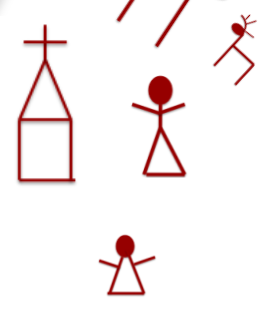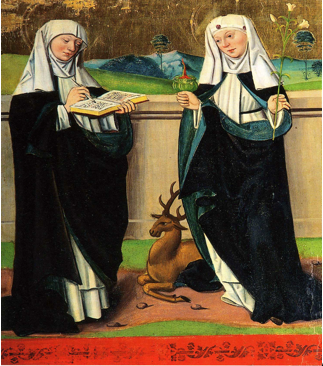Chapter 14. Vadstena [August 30, 1347]
Cultural Explanations
 |
Chapter 14. Vadstena [August 30, 1347] Cultural Explanations |
|
 |
In this chapter Bávlos becomes acquainted with the Lady Fina and her mother Birgitta. |
| Church, the tall Lady Fina and short Lady Birgitta |
In this chapter, Bávlos meets with both St. Catharina Ulf's daughter and the visionary St. Birgitta. He begins to learn Swedish and receives new instructions on his mission, ones which direct him across mainland Europe on a trek to the papal city of Avignon.
Because of his sudden bout of aloofness, Bávlos has not had an opportunity to talk with many people in Sweden before his conversation with Catharina. Thus, here we see him confronting for the first time a Germanic language. Part of the difficulty in communicating with the young woman at first is the fact that northern Sámi language has such a rich array of words for various kinds of reindeer. You can read more about Sámi reindeer terminology and other forms of traditional knowledge in Ole Henrik Magga's fine article "Indigenous Knowledge Systems—The True Roots of Humanism." The reindeer terms used in this chapter are taken directly from Magga's glossary and discussion.
The young woman whom Bávlos meets in the carriage is a historical personage: St. Catharina (1332—81) of Vadstena. Born of St. Birgitta (see below), she had become married to the nobleman Eggert von Kyrnen at the age of twelve or thirteen. In 1347, when this scene of the novel takes place, she is fifteen. In accord with many pious nobles of their day, Eggert and Catharina had taken a vow of celibacy. St. Catharina is said to have been a kind and understanding person, who had a miraculous ability with foreigners and animals. She is said to have sheltered a wild deer from hunters (as discussed in the last chapter), and church art often depicts her with a deer crouching at her ankles. She is also said to have been able to translate for a Finnish pilgrim in Rome, even though she didn't speak Finnish. These details underlie her portrayal in this chapter. I have written about Catharina in my chapter "St Katarina in Her Own Light" in Sanctity in the North: Saints, Lives, and Cults in Medieval Scandinavia (Toronto: University of Toronto Press, 2008).
 |
| fifteenth-century painting of St. Birgitta with her book of visions, and her daughter St. Catharina, with the deer she saved from the hunters' hounds. |
Catharina's mother was the indomitable St. Birgitta (1303—73). Raised in a noble Swedish family with close ties to the throne, Birgitta married the Swedish nobleman Ulf Gudmarsson at the age of thirteen. She bore him eight children and lived a very full secular life. In 1341—43,when Birgitta was nearing the age of forty, the couple made a pilgrimage to Santiago de Compostela on the Galician coast of Spain. The pilgrimage was arduous and nearly fatal to Ulf. After returning to Sweden, the couple retired from active life to live out their final days at a monastery in Alvastra. It is there that Birgitta met Peter Olofsson, who became one of her key advisors and confessors ever after. Ulf died in 1344, and soon thereafter, Birgitta received a vision about starting a new monastic order of nuns and priests of her own. Her vision led her kinsman King Magnus Eriksson to donate to her a castle at Vadstena, which is where this chapter takes place. Vadstena would eventually become the mother house of a great monastic order of the medieval era, the Ordo Sanctissimi Salvatoris [Order of the Most Holy Savior], better known by its common name, the Birgittines.
Birgitta is best known for her many visions, which she either wrote down herself or dictated to one of her male attendants to be translated into Latin. In medieval church art, she is often depicted holding or writing in a book. Her visions advise secular and church leaders about their duties, expain aspects of God's will, and describe otherwise murky sacred events like the Nativity or the Last Judgment. From accounts of her life, we know that Birgitta subjected herself to a vigorous daily routine of privations and prayer. I have borrowed the details presented here from what we know about medieval prayer in general, as detailed by Augustine Thompson O.P. in his study Cities of God: The Religion of the Italian Communes 1125—1325 (University Park: Pennsylvania State UP, 2005). Prostrating oneself before a crucifix was a normal manner of prayer, particular for the very pious (see Thompson 347).